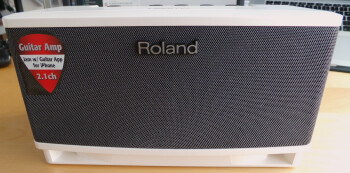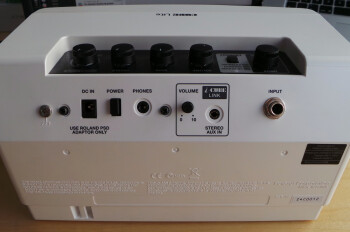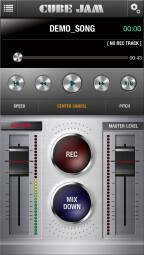In order to counter the successful Yamaha THR10 and THR5 "coffee table amps," Roland announced the launch of the Cube Lite during the last NAMM, which extends the well-known Cube series.
The new amp of the Japanese manufacturer is not the first member of the Cube series. Take a look at Roland’s catalog and you’ll count no less than seven models, from the very compact, battery-powered Micro Cube to the powerful 80-watt Cube 80XL and the Cube Street, to play on the street.
To find a place among this rich product range, the Cube Lite was developed with a specific user in mind: the living-room guitarist who nonchalantly puts his amp on the coffee table and lies on down the couch while playing guitar and drinking coffee. So the product belongs to the “home practice amp” category and is destined to stay at home because it has no rechargeable battery nor battery compartment. This might seem weird at first, but it is clear that Roland’s goal was to decrease the price. The Cube Lite is €50-€100 less expensive than Yamaha’s direct competitor products — you can get it for €150, while the THR5 and THR10 are sold for €200 and €300, respectively. This is in no way a silly idea, considering that the main disadvantage of the Yamaha THR is the price and that you always have enough power outlets at home. Besides, guitar players don’t usually have a huge budget for an amp that won’t be usable on stage or in the studio.
Rectangular cube
After you take it out of its box, you won’t find a cube but something that resembles a concrete block. Luckily it is light (3.75 lb.) and fairly compact: 9.8" × 5.8" × 5.3" (250 mm x 147 mm x 135 mm). The housing is made out of white, red or black plastic. Ours is white and nice looking, especially compared with the other Cubes that look simply awful. We would prefer a cloth covering in front of the speakers (three speakers in a 2.1 system) but that’s a matter of taste. The style is very different from that of the THR. The latter look like amplifier heads with their metal housing and classic knobs. The Cube Lite doesn’t look like a standard guitar amp, and that’s not a bad thing because it won’t go unnoticed in a living room.
COSMetic ethics
The least we can say is that the Cube Lite is simple: drive and volume knobs, two-band EQ (bass and treble, no mid) and a control to set the amount of the two available effects.
Yes, you get only two effects: chrous and reverb. The chorus sounds pretty good but we find the reverb is a bit too long and won’t suit all music genres. Moreover, we miss a delay/echo effect… You get three different COSM amp simulations: JC Clean, Crunch and Extreme. Both Clean and Crunch sound very nice, with a lot of bottom-end considering the size of the amp. The Extreme setting doesn’t really match the music genre I like and requires precise EQ settings otherwise the sound is too dull or too sharp. However, the sound is quite usable considering the amp’s price and size. The EQ is quite effective even without a mid control and allows you to shape the sound the way you want. The controls are easily accessible when the amp stands on a coffee table, but not so on top of a desk. The only negative thing is the lack of a tuner and a metronome. This is THE main drawback. However, you’ll easily solve the problem with an iOS app (I recommend GuitarToolKit)…
iAmp
On the rear of the amp you’ll find a headphone output, a guitar input and the i-CUBE link connector, which is in fact an additional input+output via a 4-pole minijack cable (included). This cable will allow you to feed the Cube Lite with an external playback source, and also to send the sound of your guitar to your iWhatever. A small control allows you to adjust the playback volume.
Moreover, Roland offers the Cube Jam app on the App Store. It gives you the possibility to record the sound of the Cube Lite, to play something back (it can access the library on your iWhatever) and to create a mix of your super solo on top your favorite song for posterity. You can change the pitch and the speed of the playback. It’s simple and comprehensive, however, it’s a pity that the app doesn’t include any real playbacks, except for a not-so-bad DEMO_SONG. The product should offer at least one song per music genre like rock, blues, metal, and pop.
There is good news for those of you who already have amp simulations on your iWhatever (like AmpliTube): the Cube Lite also allows you to send the dry sound of your guitar directly into your Apple device. And you can then send everything back into your Cube Lite: cool! The latency time is perfect but we noticed a loss in low frequencies, certainly due to the iPhone itself. When we reviewed Apogee’s Jam, we noticed that the iPhone input is not of the highest quality and that it is preferable to connect an audio interface to the dock and use its converters.
Here are some audio examples recorded with an Audio-Technica AT-4040 microphone placed a few centimeters in front of the amp.

- Clean 00:21
- Crunch 00:14
- Crunch 2 00:15
- Sat 00:14
- Chorus 00:13
Conclusion
The Cube Lite will surely win a lot of fans. For €150, it offers a pretty good sound allowing you to practice under good conditions, plus it looks nice and is fairly compact. The iOS app and the iCube connection are valuable features, even if we miss real songs to practice with. The lack of a metronome and a tuner are its main cons, especially for a practice amp. However, if you’re looking for a good-sounding and compact amp that fits on a shelf, you have enough power outlets in your living room and only €150 in your bank account, the Cube Lite is the way to go. People who have more money can consider purchasing a THR that offers additional features like an integrated tuner and battery operation.




